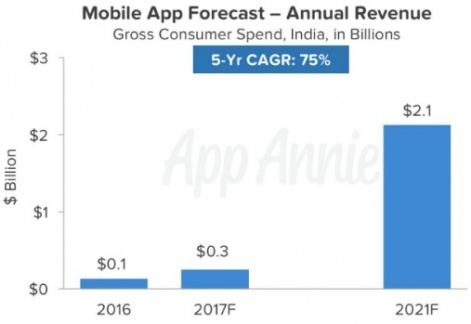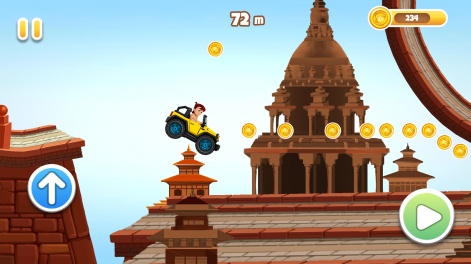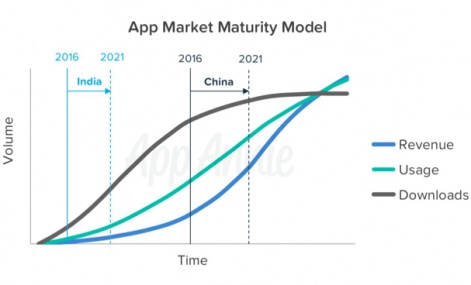A recent App Annie report projects nearly 23 billion app downloads from India in 2021.
Inspired by the "spectacular growth in smartphone ownership" predicted in the coming years, App Annie forecasts that this increase in downloads will push consumer app spend in India to $2.1 billion in 2021.
That would represent a massive annual growth rate of 75%, albeit from a small base. But even if revenues do grow at the rate App Annie expects, India will still constitute less than 2% of global app spend.
“Purchasing power in India is significantly lower than mature markets and this is compounded by the fact that cultural norms favour saving over discretionary spend on gaming and entertainment,” reads App Annie's reasoning.
In light of this report, we asked our Indian Mavens:
- With mobile gaming growth in India reliant on increasing smartphone penetration, will it rapidly hit a ceiling as hardware adoption levels out?
- Is a wider cultural shift needed to take the next step?

Shailesh Prabhu is an Indie Game Designer from India who has been designing games for over ten years. Seven years ago he founded Yellow Monkey Studios and is the recipient of numerous game design and entrepreneurship awards around the world. Socioball, HUEBRIX, It’s Just a Thought are some of his recent games. Shailesh is also an excellent cook, loves playing tennis, gardening and DIY projects apart from sporting facial hair.
Of course the adoption will eventually even out, but its not just about "owning a smartphone" which is how most studies end up calculating penetration.
Nor is it about "having 3G on your phone", as we all know how many people have got 3G automatically activated or got it on flash offers from telecom companies like "recharge now and get 1GB of 3G data free!"
The real game-changer was and will always be the cultural shift.Shailesh Prabhu
It's about actually using it to play games, how involved you get in them and your willingness to pay. The real game-changer was and will always be the cultural shift.
Sure, some people do that already - I am totally expecting a backlash to this comment saying: "I met a friend's driver who was playing Candy Crush, hence India plays games!" - but sadly that does not mean that everyone is playing, or paying for that matter.
Have you tried playing Clash of Clans while squatting over an Indian toilet to poop? Have you tried playing Angry Birds on a packed local train in Mumbai? There are millions of nullified use cases here.
Of course we need a massive cultural shift and that will not come in one day, one month or one year. We should not expect it or sell our projections as truths to our own developers either.
Sure, maybe you can hit a niche of selling Teen Patti games to a vast majority of shop owners with downtime, but that doesnt mean the Indian masses are actively seeking out content in that they will download a game with unknown mechanics and make it a big hit.
If so, please tell me where are those big hits and what are their numbers?
Yes, there's an increase in terms of downloads on the Play Store, but it's still a big "no" to IAP or any payment (other than the games in betting/gambling genres).
Economy design plays a huge role in monetising, especially ads. At least people from tier one cities (like Bangalore, Chennai, Mumbai, Hyderabad and Delhi) are playing with their mobile data turned on.
I believe the mobile game market will grow irrespective of smartphone penetration (with $150/200 phones) as it’s more inclined towards the mobile data package rates available.
One of the cornerstones of modern capitalism is growth. This is the foundation on which the stock market is built, and the forecasts of companies and countries are based.
Whether it’s the GDP rate of a country, the compound annual growth rate for an industry or the earnings-per-share growth rate of a company, every factor of capitalist success in the modern world is measured by how fast it’s growing.
Back when I was in college, I used to ask my MBA friends, “well, how can something keep growing forever?” and what I eventually understood after hours of arguments and discussions, was that growth does not only come from one factor alone, but a combination of multiple factors.

And that’s what I think we will see in the games industry in India. To the question of whether the smartphone growth in India will cap off eventually: well, of course it will. That's as much a given as ‘death and taxes’.
But let's try to answer the more pertinent questions. While the smartphone growth is happening, will the games industry also see a parallel growth?
And once the smartphone growth slows down or reaches a cap, will there be continued growth? To answer the first question, let’s just do some basic math.
If 100,000 users of a particular game makes $100 in India, as opposed to making $1,000 in matured markets in the world (clearly the conversion ratio is not good in India, and App Annie has acknowledged that in their reports), then will 400,000 users make $400?
My view is that even if we say that the new users being added have lower spending power, the overall dip in average user spend will dip a little bit but those 400,000 users will still get in about $350.
The people who can actually answer these questions have seen Indian downloads in the hundreds of thousands.Hrishi Oberoi
The answer to the second question of “will we continue to see growth post the cap?” is a more complicated one, and that is where factors such as cultural shift still come into the picture.
Yes, there is a need for a cultural shift along with other factors to kick in for continued growth, and I’m not going to wax eloquent about growing digitisation and general GDP growth etc.
I’m not really sure whether any of this will actually affect the overall average user spend on games, but the truth is that if one variable of the equation changes (overall increase in number of users) and even if a few factors affect the other variable (increase in average spend per user) then growth is not only possible, but inevitable.
The truth is though, from the perspective of pure statistics as opposed to subjective speculation, the people who can actually answer these questions are the people who have seen the downloads of their games from India in the hundreds of thousands, year after year.
Only they could give credence to the growth of downloads year after year and the corresponding average revenue per user increase. Everyone else, including all of us here, would just be speculating.
It's quite hilarious to think the tendency to save money may be what is causing hiccups to the spend.
When a Porsche-driving surgeon buddy calls you up and asks you where to get a good pirated copy of Mass Effect: Andromeda to play on his Alienware Area 51, that is when you realise this has nothing to do with saving.
There is a natural tendency over here not to pay for anything digital. Something that can't be physically felt tends to remain unworthy of well-earned money.
Sure, the casino genre works in India because money is being spent on getting a different form of currency at 100x or 500x value, the feeling of being pseudo-rich and of course, feeding the gambling addiction.
For every other genre of games, downloads from India will start making a real difference in IAP - as well as in ad revenue - when the downloads from India are at 15x or 20x for every download from a most-valued tier 1 country.
I believe the supposed cultural shifts are already happening.
I believe that by 2021 the mobile gaming growth - which I define as the share of revenues that the hit games will earn - will have really exploded, though the growth may come in fits and bursts, and we will all become used to "a new normal".
Growth may come in fits and bursts.Nalin Savara
I believe India in 2021 will have an ecosystem of Indian indie developers who earn a lot from gaming, like they have in the USA.
It is said that the humble acorn holds the seed for a mighty oak, but nobody knows which of the millions of acorns will grow into an oak - even as many lie on the ground to be stored away by squirrels to get eaten through the winter.
I personally suspect that is also going to be the case with many Indian gaming startups and even established players.
To take an example from a related but separate field, today Chhota Bheem is an undeniable hit, with the ability to pull even any game property associated with it to stratospheric success!

Chhota Bheem is such hot property and is totally Indian. And though it rose from Indian mythology, it has the potential to cross cultural boundaries and become pan-Asian - or even Global.
But if one sees how animation evolved in India to the point that Green Gold Animation was able to produce a Chhota Bheem, we saw history in fits and bursts with broken hopes and false starts.
Even in 2002, I had the privilege of watching some of the folks behind Lakshya [Bollywood movie] produce animated content for a major Canadian company.
Right through the 2000s, one would hear of state governments offering incentives for animation and filmmaking studios.
But one also saw back in 2006 or 2007 how Hanuman, a Delhi-based studio run by friends of mine, faced bankruptcy even after it had flirted with success producing episodes for a bigger client - which in turn was shipping them to yet another client.
However, today we have Chhota Bheem.
By 2021 or 2022, we will definitely see at least a few big hits come out of India.Nalin Savara
And whether or not we have visibility on what will be the next Chhota Bheem, even if we can't definitively explain why similar content like Little Krishna didnt do equally well, we know we have a new normal with regard to both the content's magnetic ability to draw eyeballs to games and toys based on it.
We also know that it has defined a new normal with regard to the kind of market leverage Chhota Bheem has in terms of it's ability to demand and dictate both licensing fees and licensing terms.
I suspect we will see a similar story with games too, with hit content which defines new normals! But it would be accelerated to a four to five year timescale instead of the 10 to 15 year timescale we saw for the Indian animation industry.
I believe that out of nowhere in the next four to five years, by 2021 or 2022, we will definitely see at least a few big hits come out of India.
But we will see content that plays out as a hit as not exclusively Indian, but just produced by an Indian studio.
Whether we continue to see smartphone growth or whether the smartphone growth plateaus, buying online and paying for digital goods - whether over mobile or on PC - will continue to become more and more ubiquitious.
It is just a matter of time and just a few more cycles of content released, and boom! We will become accustomed to a new normal, and expectations from hit games - whether in terms of downloads, active users or revenue - will get redefined.
Thus, I personally am super optimistic about the state of the Indian gaming industry we will see in 2021!
Gaming in India is in its introductory stage. Smartphone adoption is in its growth stage.
It will take a few more years for India to get into the growth stage with gaming. By then, the smartphone market with be a mature one.
Mature in terms of device capabilities, frictionless payments, payment habits and cheap data plans. That is the perfect stage for locally relevant content to take off.
Other macro-economic trends like per capita GDP will also play out in parallel and by 2021, things should really be in place.

Currently, our culture and way of life associates gratification with something tangible, real-word, physical.
We like to buy stuff that we like to flaunt in real life (the popularity of Bullet bikes being a case in point; there are a hundred others).
Gaming gratifies players, but in a virtual way, with a virtual audience. That switch to virtual gratification will definitely happen.
Just like China now, India will start off as a high MAU, low ARPPU market in a few years.
Mature markets like Japan/Korea/USA are already high ARPPU but (comparatively) low MAU. China will probably move into that league in five years and probably India probably another 10 years post that
Yes, all of this is speculation. But it is speculation on which we are betting our company.






















